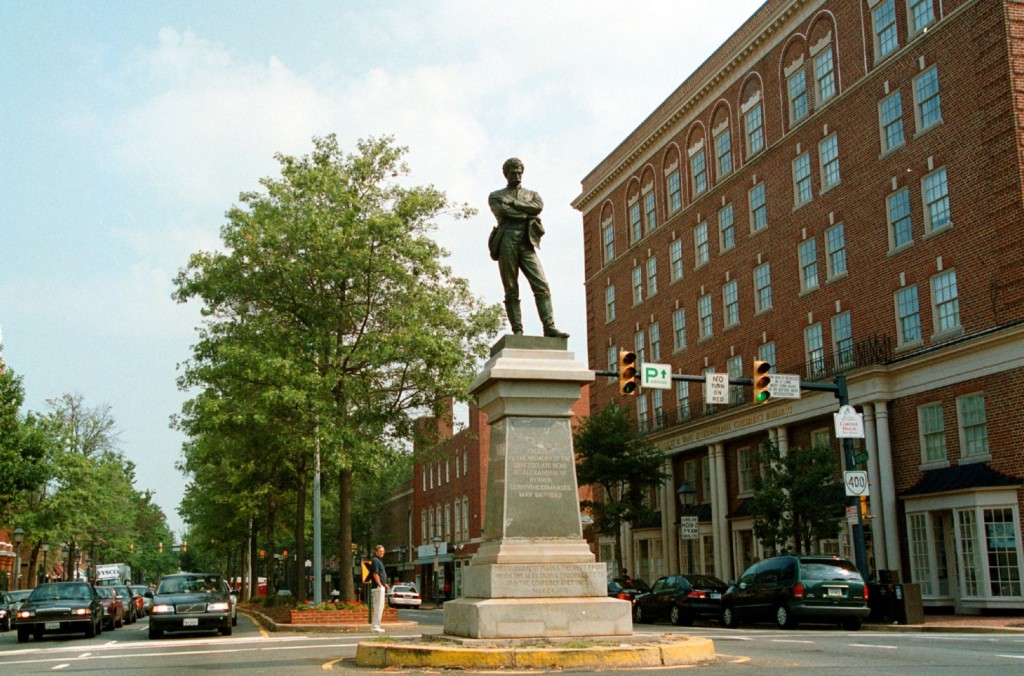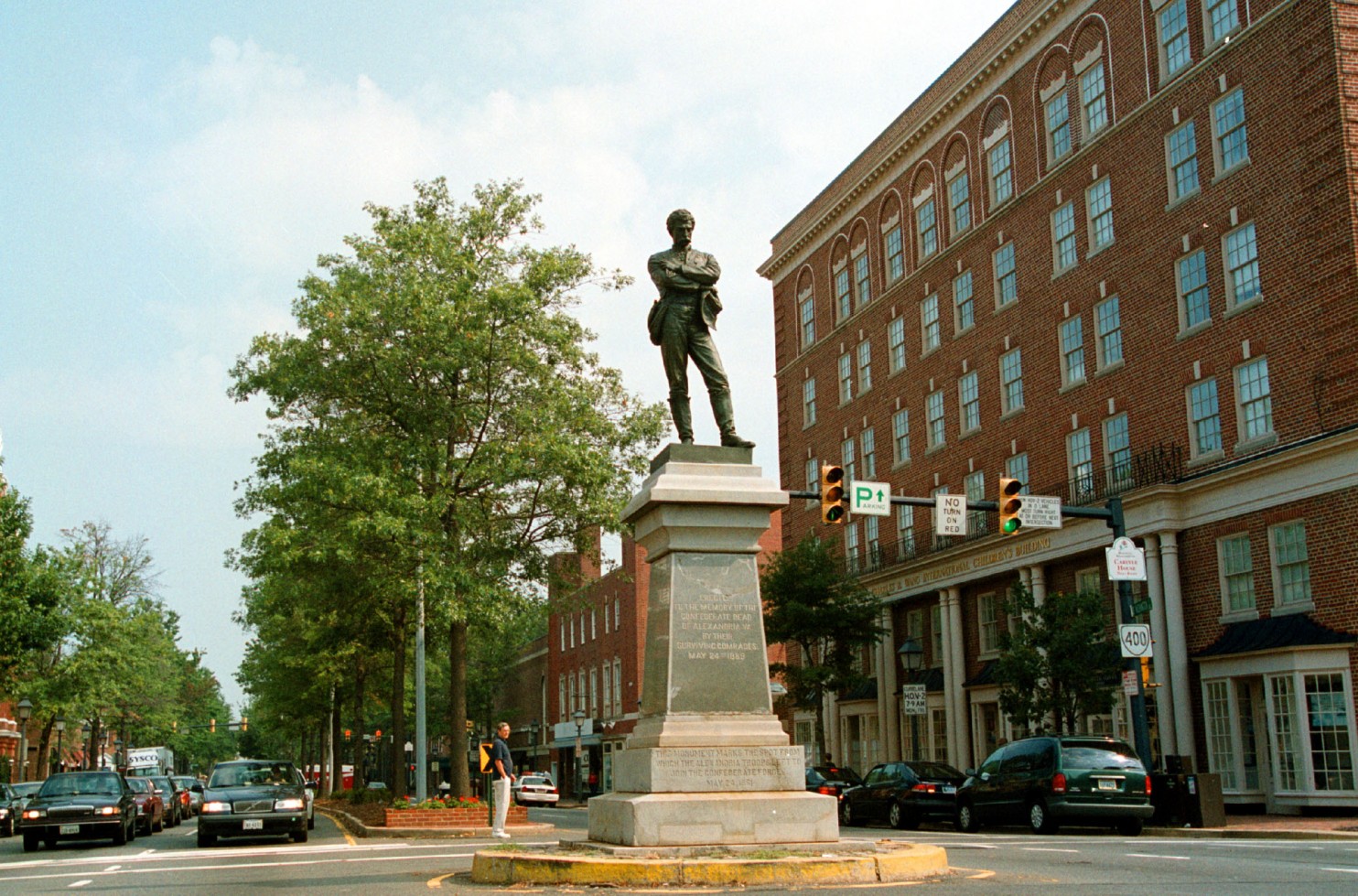VIRGINIA: Despite Alexandria Council Vote, Little Chance Appomattox Statue Will Be Removed
ALEXANDRIA, Va. — The mayor of Alexandria met with the president of the local chapter of the United Daughters of the Confederacy for the first time last week, hoping to get her cooperation in moving a controversial Confederate statue from the middle of a busy Old Town intersection to the lawn of an adjacent historical museum.
But there is no sign that any such partnership will be forthcoming, and several state lawmakers say it is extremely unlikely that the City Council’s Sept. 17 vote to evict the “Appomattox” statue from its 127-year-old post will be successful.

The Confederate memorial statue, “Appomattox” at the intersection of S. Washington and Prince streets in Alexandria. (Dayna Smith/The Washington Post)
“We shared our frankly different perspectives but in a cordial, friendly way,” Mayor Allison Silberberg (D) said of her meeting with UDC chapter President Deborah Mullins. “I respect her right to her opinion — I respect we have a different perspective on where the statue could be.”
The mayor would not say whether Mullins agreed to move the seven-foot bronze of a southern-facing Confederate soldier, which is owned by the Southern heritage group but located on city land. Mullins, in an email, declined to comment.
In 2009, she told The Washington Post, “What’s offensive to me might not be offensive to you, and vice versa. Everybody should be able to celebrate their heritage.” This week, she referred calls to the national headquarters of the organization, whose president, Pamela Trammell, did not return messages left for her.
But the group’s cooperation is just the first problem the city would have to solve to accomplish its goal of moving the monument, which the council voted to do on the same day it decided to rename the Alexandria portion of Jefferson Davis Highway.
[Alexandria will seek to move Confederate soldier statue]
Virginia law prohibits municipalities from moving war monuments or memorials. To move the statue, the city would have to get that law changed or rescinded — an unlikely prospect in the Republican-controlled General Assembly, which tried this year to strengthen the existing prohibition, only to have that bill vetoed by Gov. Terry McAuliffe (D).
Alexandria officials said they will include a proposal to modify or eliminate the ban as part of their formal legislative package, which is typically completed in late November. But lawmakers who represent the city are not optimistic about the chances of moving the statue to the lawn of the Lyceum, Alexandria’s history museum, which is located on the same corner. The lawn is also owned by the city.
“I don’t think it’s a viable proposal, unless the Daughters of the Confederacy are willing to stand up and testify. I think it’s a non-starter,” said state Sen. Adam Ebbin (D-Alexandria).
A spokesman for House Majority Leader William J. Howell (R-Stafford) said it would be “difficult to predict” how the city’s request would fare before the legislature.
The “Appomattox” statue has long been a source of controversy in this town, which was occupied by Union troops the day after Virginia seceded. Reportedly based on a drawing of an unarmed Confederate soldier observing the surrender of the Army of Northern Virginia at Appomattox Court House, the statue depicts a soldier facing south, head bowed in deep contemplation.
It was erected in 1889, at the site where a local regiment mustered to beat a hasty retreat just ahead of the Union occupation, and was intended to honor the local Confederate war dead. About 100 names are inscribed on its granite base.
In 1890, the United Confederate Veterans persuaded the legislature to pass a law that said that “the monument shall perpetually remain as at present erected and located at the intersection of Prince and Washington Streets . . . [it] shall not be repealed, revoked, altered, modified, or changed by any future council or other municipal power or authority.”
When a drunk motorist smashed into the statue and toppled it 98 years later, residents were divided about whether it should be restored.
Former City Council member Nelson E. Greene Sr., a black community leader, said at the time that the city should not re-erect the statue, and should view the accident as a sign that “the Lord works in mysterious ways.”
“Do you reckon that they’ll put it back?” one Lyceum volunteer asked another, according a 1988 Washington Post article about the accident.
“They better,” the reply came. “They’ll have an uprising if they don’t.”
That person was right. A few months later, the City Council voted to restore the statue. The city also built a median strip on Washington Street, south of the statue, to guide traffic around it.
Last year, there was a fatal shooting of nine people at a historic African American church in Charleston, S.C. The man charged with the killing was earlier photographed with a Confederate flag. In the months since, states and municipalities throughout the nation have been reexamining their Confederate memorials.
In Alexandria, the council banned the flying of the Rebel flags by the city, which had been a tradition on Confederate Memorial Day and Robert E. Lee’s birthday.
Feelings about the council’s latest decision remained raw last week. City clerk Jackie Henderson said the council had received “a couple dozen” phone calls and about 100 emails. Early Wednesday, someone posted a handwritten sign on the “Appomattox” statue that said: “Alexandria City Council Cowards!”
–washingtonpost.com
###
ALABAMA: Memorial to Confront South’s Troubled History of Lynchings
MONTGOMERY, Ala. — Southern states have long welcomed tourists retracing the footsteps of the late Martin Luther King Jr. and others who opposed segregation. Now the Alabama city that was the first capital of the Confederacy is set to become home to a privately funded museum and monument that could make some visitors wince: a memorial to black lynching victims.
The nonprofit Equal Justice Initiative has announced it is building a memorial in the state capital of Montgomery devoted to 4,075 blacks its research shows were killed by lynching in the U.S. from 1877 to 1950.
The nonprofit’s director, Bryan Stevenson, said the aim is to help “change the landscape” of American racial discourse by openly acknowledging a painful past, much as Germany has Holocaust memorials and South Africa a museum on its past state-sanctioned segregation — apartheid.
He said that while hundreds of whites were lynched in roughly the same period of U.S. history, the memorial’s focus will be on “terror lynchings” against blacks in a dozen Southern states — whether by hanging, gunshots, beatings, burnings or other forms of killing used in the past to terrorize black communities.
“I don’t think we can afford to continue pretending that there aren’t these really troubling chapters in our history,” Stevenson said. “I think we’ve got to deal with it.”
Set to open next year on the site of a former low-cost housing project, the monument is to be accompanied by a museum a few blocks away exploring the history of blacks in America from slavery to the present.
Work is already under way on both. How they will be received is an open question.
Pausing at a historical plaque while visiting Montgomery’s civil rights sites, North Carolina tourist Nancy Lange hesitated at the thought of a lynching memorial. “That is tough. I can’t even think beyond that word,” said Lange, 58, who’s white.
But daughter Teresa Lange, 27, said a memorial could be valuable in teaching about America’s racial past and fostering conversation about today’s climate of Black Lives Matter, police violence against minorities and racial strife.
“How many people talk about lynching? How many people talk about the hate crimes that still go on today?” she said. “As a tourist I think it would be a good thing. … I’d go see it.”
Equal Justice Initiative said the monument and museum also would help counter glorification, in some quarters, of the Confederacy across the South while telling the painful story of race in America. The law firm and its founder, Stevenson, represent death row inmates and advocates for racial justice.
The group already has erected bronze plaques around Montgomery to denote bygone slave markets; another group has built a memorial honoring civil rights martyrs, mostly African-Americans. Elsewhere in Montgomery, a marker explains the history of the church parsonage bombed while King lived there in 1956.
The monument set for a hill in view of Alabama’s Capitol — where the Confederacy was formed — is to include thousands of names of lynching victims etched on hundreds of concrete columns. Each column represents a U.S. county where a lynching occurred. The names were gathered both in past research and new work by Equal Justice Initiative.
The nearby museum is to house what organizers describe as the nation’s largest collection of information on lynching. Located in the nonprofit’s headquarters, it also will include presentations about the domestic slave trade, racial segregation and the incarceration of large numbers of blacks today.
Stevenson said the final design of both the memorial and museum will depend on fundraising, though the Ford Foundation already has given $2 million.
Alabama tourism director Lee Sentell said the project has the potential to be important. But he said his agency will need to find out more about the new project before deciding whether to promote it alongside civil rights attractions such as the Birmingham Civil Rights Institute or the Edmund Pettus Bridge in Selma, where marchers for voting rights were beaten by state police in 1965.
“It is a difficult subject for most all of us Southerners to contemplate because people who are alive today have never had to give this subject much thought,” Sentell said. He added of the memorial that “the execution of the details will either make people glad they visited the location or not.”
He said Alabama began promoting civil rights sites for tourism in the 1980s. A “Black Heritage Guide” published then was updated and later morphed into the “Alabama Civil Rights Trail,” a guide of museums and historic sites.
Not everyone is on board with a lynching memorial.
Marlin Taylor, an African-American visitor from Spokane, Washington, was surprised by it.
“With the climate in America right now I don’t know that that’s a good idea,” Taylor said at the civil rights memorial outside the Southern Poverty Law Center, a public interest law firm. “I feel like that could be more divisive than anything.”
But the Alabama commander of the Sons of Confederate Veterans, Jimmy Hill, supports it. He said telling the story of the lynchings will help people understand America’s tangled, painful past.
“Yes, it’s going to hurt some people. There are some people who are going to see that and say they wish the story wouldn’t be told. But we are on the opposite side of that. We just want the whole story to be told,” Hill said.




